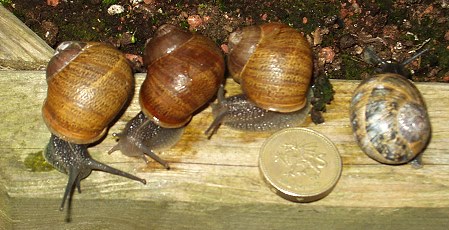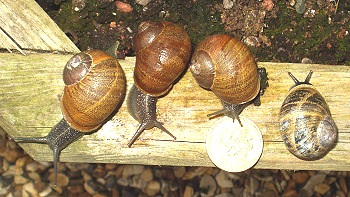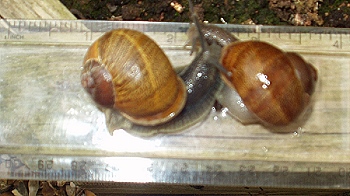|
Data:
My name is Alan Hendy and Iam an amateur Naturalist here in the
UK. I am familiar with most species of snails here in the UK including
the common garden snail Helix aspersa and Helix pomatia apparently introduced
by the Romans.
The Helix aspersa as you will most probably know is now a global
species and highy variable in the shell colour shading and pattern however,
i found these specimens that are quite unlike anything that i have seen
before and despite searching the internet for photos/descriptions they
appear not described.
What makes them different to me is the obvious lack of shell pattern,
the shell is more or less an orange honey colour, some individuals have
a very thin faint yellow line running along the centre of the shell.
The animals themselves look just like any other Helix aspersa, the adult
size is the same as the common patterned form. The location is an isolated
coastal wood in Devon in the UK. The snails are living among the the
more common Helix aspersa as mixed individuals of different ages of
up to 50 among ivy on tree trunks and other hiding places. The new form
of snail only makes up about 10% of the population as far as i can tell
after 2 visits to the site.
On my last visit to the site last Friday i removed 11 individuals
of different sizes and ages for study and safety.
Although i have contacted the London Malacological Society of London
about 2 weeks ago through their only contact that i am aware of via
email, the web manager, i am still waiting for a response.
If this possible subspecies is previously unknown then i will provide
you with more information, even if it is known please do let me know.
Below is a photo of 3 adult individuals alongside 1 individual of
the well known common colour/pattern.
Send
Ideas to:
Alan
|
|
Identified:
Cornu aspersum (Muller, 1774)
AKA:
Helix aspersa,
Cantareus aspersus
Discussions:
(Most recent reply listed first)
-
The key passage in the Article ICZN 1.3.2 is the exclusion of names
proposed "for teratological specimens as such."
Some earlier authors made names for specimens that they explicitly
considered to be freaks of known species. Presumably they regarded
these as varietal names in the modern sense. Because these clearly
were intended to designate individual variants, it seems safe to
assume that they were not intended as subspecies names. I suspect
that is the reasoning behind the Code. Since Cornu was proposed
as a new, strange snail rather than recognized as a mutant Helix,
the genus would be validly available. ... David C.
-
For some years in the 1960's and 70's the enterprising Francois
Picart raised Cornu aspersum near Santa Rosa, California,
and sold them to fine restaurants. I think he also produced a frozen
version that was sold in markets. I had the distinct pleasure of
sampling Francois's product, both en croute and creamed with spinach.
(The fact that both were prepared by gourmet chef Narsai David and
offered at a charity function could have had to do with my joy at
the experience.)
Picart published an entertaining little book, "Escargots
From Your Garden to Your Table," which should be in every malacologist's
library. Amazon.com's collateral sellers have a few copies available.
Tying to an earlier thread, a few years ago I missed
the opportunity to see whether sinistral C. aspersum taste
different from dextral ones when a left-handed specimen appeared
at my feet as I watered my garden in San Francisco. (I thought the
malacological gods must be saying, you think you're a snail biologist?
Let's see what do you with this.) It was an opportunity to get creative,
but I had other things on my mind and dropped the ball. ... Barry
Roth
-
That correction of Jeffreys' citation takes the Helix hortensis
nomenclatorial issue off the table.
Having Sherborn on line at < http://www.sil.si.edu/digitalcollections/indexanimalium/>**
is a fantastic resource and one which would have saved me minor
embarrassment from having perpetuated Jeffreys' error. I take it
Pennant (1777) is not on-line but in your hands allowing for the
further commentary on the matter. ... Harry L.
-
The Famous (not Great) Otto Frederik Müller was indeed
a well-trained scientist, but he was not the one who named Cornu
copiae. That service came from the Austrian Ignatius Born (1778)
< http://www.jaxshells.org/cornu.htm>,
who, at least in the 1780 work, gave no indication that it was anything
but a genuine species in a genuine genus (the only non-Linnaean
one he employed) as he described both in the same sober format,
style, and rank as he did Helix, Nerita, and Murex; Helix
polygyrata, Nerita polita Linnaeus, and Murex rapiformis.
Born was certainly a pioneer as you infer, but I think any reviser
would be on very tenuous ground to infer that he was anything but
serious about the taxonomic standing, as he saw it in those pioneer
days, of Cornu copiae. I think the issue is: upon whom is
the burden of proof: those who think that a retrospective analysis
of an aberrant specimen, or those who see Born as honestly ignorant
of this quirk of nature. The key passage in the Article ICZN 1.3.2
is the exclusion of names proposed "for teratological specimens
as such." Writing from limited experience, I don't think the
august Commission would even consider a petition to suppress Cornu
under ICZN 1.3.2 in the face of "as such" in the Rules.
-
In the course of looking into this problem this AM, I came across
< http://www.weichtiere.at/english/gastropoda/terrestrial/escargot/cornu.html
>, which does a better job than I with other parts of the
story. ...Harry L.
-
These are Cornu aspersum (Muller, 1774) aka Cantareus
aspersus or Helix aspersa. They are more variable in shell
colour (and size and shape) than some people think. I have specimens
very similar to the ones in the photo from sites in Iberia. To completely
satisfy taxonomic curiosity, you would need to sacrifice and dissect
one of the specimens you have. However, conchological features,
as well as external body features (both sufficiently well visible
in the photo), clearly (I think) clinches the ID....Alex
-
I agree completely with Alex Menez and Henk Mienis: it is "Helix"
aspersa. With a caveat -the nomenclature of this little creature
is unclear. As pointed out by others, it barely fits into Helix
(the French escargot and similar bulky beasts). Giusti et al. placed
it into Cantareus, the type species of which is aperta...
but in spite of similar penial structures, that is a very different
animal, unable to retreat completely into its thin shell! Now, if
aperta deserves a genus of its own (as I think), we have
two available names: Cryptomphalus and Cornu. The
former has been widely used, and is unequivocal for this species.
The latter is an older, recently resurrected name based on a scalariforn
(i.e., teratological) specimen. The Code states that teratological
types render names invalid, but it has been argued that this does
not apply, because Cornu was created without knowledge of
the scalariform shell being a monster. I don't buy that, because
the author of the name Cornu was a trained, even if pioneering
European malacologist, who would have been undoubtedly able to identify
"Helix" aspersa, scalariform or not. Back
in 1774, Mr. Müller was pointing at a fashionable curio, not
really naming a new taxon! Thus, I am inclined to suppress Cornu
forever. Any thoughts?
Sincerely, ...Cristian A
-
Cornu aspersum (Müller, 1774); see < http://www.jaxshells.org/cornu.htm>
and < http://snailstales.blogspot.com/>
as well as several Conch-L postings over the yeas. It is probably
native to the U. K. Jeffreys (1862: 181-185) discusses its pestilent
presence in English gardens and methods of extermination. Curiously
he states that the snail is "occasionally eaten by the French,"
but reserves such human consumption to a "broth ... used for
pulmonary complaints."
Like Barry Roth said of the European Discus rotundatus (see
below), it has been introduced to California (and elsewhere in the
U.S.), where it is neither eaten nor used as a medicinal (even in
California!?)
Here's a poser for taxonomists and nomenclature buffs: Jeffreys
(1862: 184) states that Pennant named this species Helix hortensis
in 1766, which, if available, would be an earlier name for this
species and a senior homonym for Helix hortensis Müller,
1774 [now Cepaea hortensis (Müller, 1774). Has any action
been taken on this apparent problem? ...Harry L.
Jeffreys, J. G., 1862. British Conchology 1. John Van Voorst, London.
frontispiece + cxiv + 1-341 + pls. 1-7.
-
They look pretty atypical of the Helix aspersa (or whatever
they are called these days) that I have growing in my garden.
The shells seem to change a bit with the plants they are consuming...
from pot
to pot, bed to bed. ... but the key is the same old animal. ...Leslie
A.
-
I agree with Alex. Most of the varietal names given to Cornu
aspersum have been enumerated by J.W. Taylor: Monograph of the
land and freshwater Mollusca of the British Isles. Unfortunately
that work was never finished.
The figured shells fall in his category of the variety exalbida
Moquin-Tandon, 1855: shell pale yellowish or whitish, without darker
banding. He used this classification in its widest sense and it
embraced not only the whitish shells but also those various shades
of yellow, including the specimens which display a tinge of green.
...Henk M.
Other varietal names given to such shells are:
virescens Maquin-Tandon, 1855 greenish
lutescens Grateloup, 1855 yellow
luteola Bourguignat, 1863 pale chrome yellow, semi-transparent,
the lip and
interior pure white
alba Locard, 1881 white
lutea Baudon, 1881 yellow
flavescens Kregler, 1870 pale yellow
additional varieties without bands:
unicolor Moquin-Tandon, 1855 uniform fawn colour
immaculata Kregler, 1870
grisea Moquin-Tandon, 1855 fulvous or greyish
etc., etc., etc.
-
I think that Jeffreys made an error as the 1766 edition of Pennant
does not contain new species (fide Sherborn). Pennant's usage of
this name is dated from Pennant 1777 by Sherborn (who cites page
118 instead of 136). There is no reference in Pennant to an earlier
usage by him although he refers to Lister et al.
Incidentally, did you know that Sherborn's Index Animalium is now
on-line with an excellent search feature? Regards, ...Dick P.
-
Looks like Cornu aspersa to me as well. Alex is right,
they do have lots of different colour morphs, partly dependant on
the calcium availability in area, and I suspect partly diet related.
These are not as extreme as some of the forms you get down in Spain/Morocco,
which merit their own subspecies.
You didn't post this to UK Conch-List ( Robert C. would have
responded if he was around), perhaps you don't subscribed to this
one. ...Best wishes ... Mary
-
I know nothing about non-marine mollusks, but I am familiar
with the appropriate part of the Code.
What the Code actually excludes from availability are "names
proposed for teratological specimens as such." If Müller
had proposed a name for 'these scalariform specimens of aspersa'
the proposed name would not be available. In the absence of a statement
that the name applied to an aberrant form of an already named species,
his proposed name is available.
It is not possible to know that Müller could identify his aberrant
specimen as an already named species. The literature continues to
be cluttered with names proposed for "species" that were
not recognized by their "expert" authors as only forms
of already named species. ...dick p.
- Helix pomatia and Cornu aspersum ...Regards...Charles
G.
|


